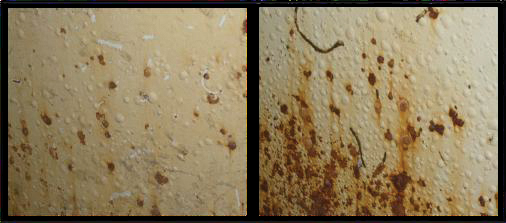The success of a tank lining project relies on many factors, including internal design to prevent corrosion; a well-written specification; lining selection; an experienced contractor; and, of course, continuous coatings inspection throughout the project. In CORROSION 2014 paper no. 3763, “Premature Coating Failure of a Tank Lining System,” byJ.A. Padilla, L.A. Koloffon, R. Benedith, and L.M. Gomez, the authors tell the story of a 10.2 million L aboveground storage tank (AST) for treated water, located in a 600 MW combined-cycle power plant in the northwestern part of Mexico. The AST did not have an internal cathodic protection system installed.
After seven years in service, the AST was showing generalized corrosion on the roof and supporting structures. An inspection of the tank was requested by plant personnel who could see “some corrosion” through an opened hatch on the roof while the tank was in service. The inspection showed a heavy buildup of corrosion byproducts and pitting corrosion, with the most severe corrosion found on the supporting columns, the roof plates, and supporting structures. The roof structure was corroded over ~70% of its surface and many supporting beams were completely corroded. In many cases, the lining system could not be seen. As part of the tank evaluation, corrosion rates and remaining life calculations of the roof plates were made so future maintenance activities could be prioritized and planned.

A few months later, a powerful earthquake hit the area. The water level inside the tank was at its maximum at the time, and the wave action exerted tremendous stresses on the on the roof and the supporting structure, which caused the partial collapse of the roof and the bending and collapsing of several rafters and other supporting elements.
To understand the forces that were acting in the tank at the moment of the earthquake and their relationship with the corrosion damage on the supporting structures, a computer-aided design (CAD) model was created and finite element analysis was done. This case study describes the tank inspection, reviews the extent of the corrosion damage, discusses the factors that contributed to the early onset of corrosion, and comments on related inspection costs that might have prevented the corrosion and tank failure.
The paper can be downloaded from the NACE International Web site at nace.org/store.